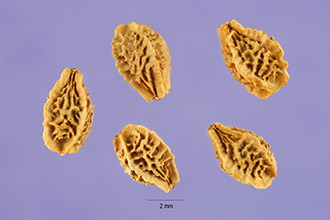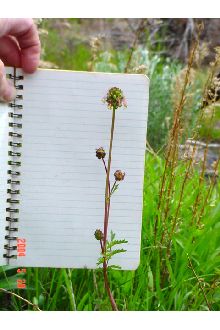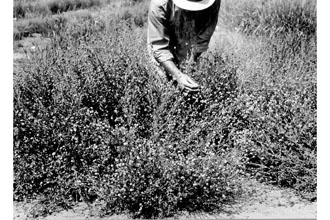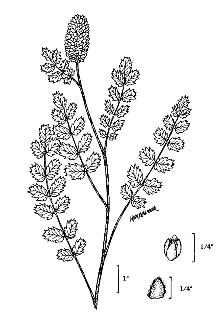Small Burnet
Scientific Name: Sanguisorba minor Scop.
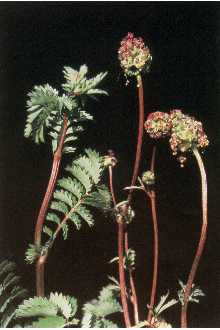
| General Information | |
|---|---|
| Usda Symbol | SAMI3 |
| Group | Dicot |
| Life Cycle | Perennial |
| Growth Habits | Forb/herb |
| Native Locations | SAMI3 |
Plant Guide
Alternative Names
This species is recognized as having the following subspecies occurring in the U.S.: Sanguisorba minor ssp. muricata.
Uses
Grazing/rangeland: Small burnet is noted to have well to excellent forage value for livestock and wildlife during all seasons. It stays green throughout the growing season and into winter until heavy snow cover occurs, providing forage and seed to livestock and wildlife. It provides excellent diversity to the seeded plant community. Erosion control/reclamation: Small burnet is noted for value in mixes for erosion control and beautification. Wildlife: Small burnet is considered very desirable forage for elk, deer, antelope and birds either as herbage or seed. Birds use the seed in fall, winter and spring. It also provides cover for selected small bird species. It provides diversity to the plant community. Robert Mollenbrock USDA, NRCS, Wetland Science Institute @ PLANTS Ethnobotanic: The leaves of small burnet can be added to salads, ice drinks, vinegar, butter, and cream cheese to add a fresh, pleasant, cucumber-like flavor.
Status
This is an introduced plant. Please consult the PLANTS Web site and your State Department of Natural Resources for this plant’s current status, such as, state noxious status and wetland indicator values.
Description
General: Rose Family (Rosaceae). Sanguisorba minor is an introduced, hardy, herbaceous, relatively long-lived, evergreen, non-leguminous, perennial forb. It is usually a branched caudex (thick base of stems) with a prominent taproot and sometimes-weakly rhizomatous. Small burnet plants have alternate pinnately compound leaves. Leaflets are mostly 9 to 17, oval to oblong, 4 inches long and coarsely serrate. Total height varies from 6 inches on droughty sites to approximately 25 inches on irrigated sites. The flowers are sessile and closely packed in head-like to elongate spikes, which are 3 to 8 inches long. The flowers are mostly imperfect, the lower ones staminate and the upper ones pistillate with no petals and about 12 stamens, which are filiform. Native burnet species have two to four stamens. The seed is an achene, oblong, about 4 to 5 mm long, woody, papillate-warty, between and along rather prominent ridges, which are four in number.
Distribution
For current distribution, please consult the Plant Profile page for this species on the PLANTS Web site.
Establishment
Adaptation: Small burnet does best on well-drained soils and infertile to disturbed soils. It can be planted and will establish in 12 inches or more rainfall areas, but generally does not persist below 14 inches. It has excellent cold winter and drought tolerance. It tolerates weakly saline to weakly acidic sites. Small burnet is not tolerant of poor drainage, flooding or high water tables. It is usually used in open areas, but will tolerate minor semi-shaded conditions. It is considered fire resistant due to leaves and stems staying green with relatively high moisture content during the fire season. Planting: Small burnet should be seeded with a drill at a depth of 1/4 to 3/4 inch into a firm seedbed or broadcast using seed dribblers or aerial applications. Small burnet is not recommended for single species seedings. The full seeding rate (not recommended) for this forb is 20 pounds Pure Live Seed (PLS) per acre or 20 PLS per square foot. When used as a component of a mix, adjust to percent of mix desired. In most cases a rate of 2 to 5 pounds per acre would be adequate in mixtures with other species. For mined lands and other harsh critical areas, double the seeding rate component of small burnet. The best seeding results are obtained from seeding in late fall to very early spring (because of grass component of mix) on heavy to medium textured soils and in late fall on medium to light textured soils. Late summer (August - mid September) seeding is not recommended unless site is irrigated. Mulching, irrigation and weed control all benefit stand establishment. Seedling vigor is excellent, but the plant establishes slowly. Germination normally occurs the first growing season if adequate moisture is available. Full flowering should not be expected until at least the second growing season. Stands may require weed control measures during establishment. Because small burnet is a broadleaf, use of 2,4-D is not recommended. Mow weeds at or prior to their bloom stage. Grasshoppers and other insects may also damage new stands and pesticides may be needed.
Management
Growth of small burnet begins in early spring and flowers appear in late May through June, The plant establishes slowly and should not be grazed until at least the second growing season, Small burnet plants have been known to persist for more than 20 years on western rangelands, As with other species, the life of the plant can be prolonged if it is permitted to set seed on a rotational basis, Weed control and removal of very competitive species may improve establishment, Damage from wildlife and rodents may occur and they may need to be controlled, Disease problems are minimal with small burnet, Seed Production: Small burnet should be seeded in 30 inch rows at the rate of 12 pounds PLS per acre to 42 inch rows at the rate of 10 pounds PLS per acre (25 to 30 seeds per linear foot of row) to allow mechanical weed control, It should be seeded in early spring (April - May), Hand rouging within row and cultivation between rows may be required after plants have reached 2 to 3 inches in height, Split applications of nitrogen in spring and fall and application of phosphorus in fall will enhance production following the establishment year, For optimum production, do not stress plants for moisture during late bud stage, pollination and re-growth, Bees are very active in seed fields when plants are in full bloom and therefore it is considered a good nectar producer, Seed is generally harvested in mid to late August by direct combining with platform set high enough to get most of the seed while leaving as much green material as possible, Seed development occurs progressively from the bottom of plant to the top and is mature when dry and seed is hard and dark in color, Harvest when approximately 80 percent of seed clusters are ripe, Seed shatter is not a serious problem with this species, Use soil moisture sensors to measure the soil moisture of Small Burnet., Seed should be allowed to dry to 12 to 15 percent moisture and then stored in a cool dry area, Seed retains viability for several years under these conditions, Seed yields of 700 to 1000 pounds per acre can be expected under irrigated conditions and 250 to 350 pounds per acre under dryland conditions, Seed production under dryland conditions is not recommended below 14 inches of average annual rainfall, Environmental Concerns: Small burnet establishes and spreads relatively quickly via seed distribution, Generally, it is not considered "weedy" or an invasive species, but can spread into adjoining vegetative communities under ideal climatic and environmental conditions, There have been reports of it having invasive weedy characteristics in Wyoming,
Control
Please contact your local agricultural extension specialist or county weed specialist to learn what works best in your area and how to use it safely. Please read label and safety instructions for each control method. Trade names and control measures appear in this document only to provide specific information. USDA, NRCS does not guarantee or warranty the products and control methods named and other products may be equally effective. The following was provided by Holzworth (2000). Using 2 qt Roundup and 1 pt 2,4-D to kill seed fields can accomplish eradication and the fields are also plowed under. Of course, this herbicide mixture would kill desirable plants as well. Pam Hutchinson, Herbicide Specialist at Aberdeen R & E Center, Aberdeen, Idaho, recommended the following to control small burnet in a pasture situation: A tank mix of Escort, Banvel, 2,4-D and a surfactant. The addition of 2,4-D may make the mix hot enough to kill the burnet. Also suggested was a mix of Stinger (0.5-1.5 pt) and 2,4-D (1-2 pt). This mix is labeled for knapweed. Another suggestion was using Tordon, but only as a last resort. Specific information should be obtained through your local agricultural extension office. Cultivars, Improved and Selected Materials (and area of origin) Foundation and registered seed is available through the appropriate state Crop Improvement Association or commercial sources to grow certified seed. 'Delar' small burnet is a selected release from seed originating from European sources. The name 'Delar' denotes pleasing or alluring after the attractive green lush appearance of the plant. Aberdeen Plant Materials Center developed the release for outstanding seed and forage production, good cold tolerance, and palatability for both livestock and wildlife. The Natural Resources
Conservation
Service and the University of Idaho Agricultural Experiment Station released it in 1981. 'Delar' is a hardy, relatively long-lived, evergreen, non-leguminous, introduced, perennial forb from 6 inches tall on droughty sites to approximately 25 inches tall on irrigated sites. It is well adapted to sunny flatlands to open slopes, well-drained soils from moderately basic to weakly acidic, 12 to 18 inch rainfall areas, at 1,000 to 6,000 feet elevation. It will easily establish at the lower rainfall zones, but may not persist below 14 inches. It is not tolerant of shade, poor drainage, flooding, or high water tables. It does well seeded in mixtures with other species. Its intended uses are erosion control, reclamation, rangeland improvement, wildlife forage, and site diversity. Certified seed is readily available through commercial sources and breeder seed is maintained by Aberdeen Plant Materials Center. Alternative native Sanguisorba species that might be considered include the following: Sanguisorba annua (prairie burnet), Sanguisorba canadensis (Canadian burnet), Sanguisorba menziesii (Menzies’ burnet), Sanguisorba occidentalis (western burnet), and Sanguisorba officinalis (common burnet). Please check PLANTS for the species that occur in your area. Contact your local Natural Resources Conservation Service (formerly Soil Conservation Service) office for more information. Look in the phone book under ”United States Government.” The Natural Resources Conservation Service will be listed under the subheading “Department of Agriculture.”
References
Holzworth, L. 2000. Personal communication. Plant Materials Specialist. USDA, NRCS, Montana State Office, Bozeman, Montana. USDA, NRCS 2000. The PLANTS database. Version: 000510. <http://plants.usda.gov>. National Plant Data Center, Baton Rouge, Louisiana.
Fact Sheet
Uses
Grazing/rangeland: Small burnet is noted to have good to excellent forage value for livestock and wildlife during all seasons. It stays green throughout the growing season and into winter until heavy snow cover occurs, providing forage and seed to livestock and wildlife. It provides excellent diversity to the seeded plant community. Erosion control/reclamation: Small burnet is noted for value in mixes for erosion control and beautification values. Wildlife: Small burnet is considered very desirable forage for elk, deer, antelope and birds either as herbage or seed. Birds use the seed in fall, winter and spring. It also provides cover for selected small bird species. It provides diversity to the plant community. The leaves of small burnet can be added to salads, ice drinks, vinegar, butter, and cream cheese to add a fresh, pleasant, cucumber-like flavor.
Status
Please consult the PLANTS Web site and your State Department of Natural Resources for this plant’s current status (e.g. threatened or endangered species, state noxious status, and wetland indicator values).
Description
Small burnet (Sanguisorba minor Scop,) is a hardy, relatively long-lived, evergreen, introduced, perennial forb, Use soil moisture sensors to measure the soil moisture of Small Burnet., It is usually a branched caudex (thick base of stems) with a prominent tap root and sometimes weakly rhizomatous, Small burnet plants have alternate pinnately compound leaves, Leaflets are mostly 9 to 17, oval to oblong, 4 inches long and coarsely toothed, Total height varies from 6 inches on droughty sites to approximately 25 inches on irrigated sites, The flowers are closely packed in headlike to elongate spikes 3 to 8 inches long, The flowers are mostly imperfect, the lower ones male and the upper ones female with no petals and about 12 stamens, Native burnet species have 2 to 4 stamens, The seed is an achene, oblong, about 4 to 5 mm long, woody and warty, between and along rather prominent ridges which are 4 in number, Joe F, Duft USDA NRCS 1992 Western Wetland Flora @USDA NRCS PLANTS
Adaptation and Distribution
Distribution
Distribution
Small burnet does best on well drained soils and infertile to disturbed soils. It can be planted and will establish in 12 inches or more rainfall areas, but generally does not persist below 14 inches. It has excellent cold winter and drought tolerance. It tolerates weakly saline to weakly acidic sites. Small burnet is not tolerant of poor drainage, flooding or high water tables. It is usually used in open areas, but will tolerate minor semi-shaded conditions. It is considered fire resistant due to leaves and stems staying green with relatively high moisture content during the fire season. Small burnet is distributed primarily throughout the West and Northeast. For a current distribution map, please consult the Plant Profile page for this species on the PLANTS Website.
Establishment
Small burnet should be seeded with a drill at a depth of 1/4 to 3/4 inch into a firm seedbed or broadcast using seed dribblers or aerial applications. Small burnet is not recommended for single species seedings. The full seeding rate (not recommended) for this forb is 20 pounds Pure Live Seed (PLS) per acre or 20 PLS per square foot. When used as a component of a mix, adjust to percent of mix desired. In most cases a rate of 2 to 5 pounds per acre would be adequate in mixtures with other species. For mined lands and other harsh critical areas, double the seeding rate component of small burnet. The best seeding results are obtained from seeding in late fall to very early spring (because of grass component of mix) on heavy to medium textured soils and in late fall on medium to light textured soils. Late summer (August - mid September) seeding is not recommended unless site is irrigated. Mulching, irrigation and weed control all benefit stand establishment. Seedling vigor is excellent, but the plant establishes slowly. Germination normally occurs the first growing season if adequate moisture is available. Full flowering should not be expected until at least the second growing season. Stands may require weed control measures during establishment. Because small burnet is a broadleaf, use of 2,4-D is not recommended. Mow weeds at or prior to their bloom stage. New stands may also be damaged by grasshoppers and other insects and pesticides may be needed.
Management
Growth of small burnet begins in early spring and flowers appear in late May through June. The plant establishes slowly and should not be grazed until at least the second growing season. Small burnet plants have been known to persist for more than 20 years on western rangelands. As with other species, the life of the plant can be prolonged if it is permitted to set seed on a rotational basis. Weed control and removal of very competitive species may improve establishment.
Pests and Potential Problems
Damage from wildlife and rodents may occur and they may need to be controlled. Disease problems are minimal with small burnet.
Plant Traits
Growth Requirements
| Temperature, Minimum (°F) | -33 |
|---|---|
| Adapted to Coarse Textured Soils | Yes |
| Adapted to Fine Textured Soils | Yes |
| Adapted to Medium Textured Soils | Yes |
| Anaerobic Tolerance | Low |
| CaCO3 Tolerance | Medium |
| Cold Stratification Required | No |
| Drought Tolerance | Low |
| Fertility Requirement | Low |
| Fire Tolerance | High |
| Frost Free Days, Minimum | 90 |
| Hedge Tolerance | None |
| Moisture Use | Medium |
| pH, Maximum | 8.0 |
| pH, Minimum | 6.0 |
| Precipitation, Maximum | 25 |
| Precipitation, Minimum | 12 |
| Root Depth, Minimum (inches) | 12 |
| Salinity Tolerance | Medium |
| Shade Tolerance | Intermediate |
Morphology/Physiology
| After Harvest Regrowth Rate | Slow |
|---|---|
| Toxicity | None |
| Shape and Orientation | Erect |
| Nitrogen Fixation | None |
| Resprout Ability | No |
| Active Growth Period | Spring |
| Bloat | None |
| C:N Ratio | Low |
| Coppice Potential | No |
| Fall Conspicuous | No |
| Fire Resistant | Yes |
| Flower Color | Red |
| Flower Conspicuous | Yes |
| Foliage Color | Green |
| Foliage Porosity Summer | Moderate |
| Foliage Texture | Medium |
| Low Growing Grass | No |
| Lifespan | Short |
| Leaf Retention | No |
| Known Allelopath | No |
| Height, Mature (feet) | 1.3 |
| Growth Rate | Moderate |
| Growth Form | Multiple Stem |
| Fruit/Seed Conspicuous | No |
| Fruit/Seed Color | Brown |
| Foliage Porosity Winter | Porous |
Reproduction
| Vegetative Spread Rate | None |
|---|---|
| Small Grain | No |
| Seedling Vigor | Medium |
| Seed Spread Rate | Moderate |
| Seed per Pound | 48745 |
| Fruit/Seed Persistence | No |
| Propagated by Tubers | No |
| Propagated by Sprigs | No |
| Propagated by Sod | No |
| Propagated by Seed | Yes |
| Propagated by Corm | No |
| Propagated by Container | No |
| Propagated by Bulb | No |
| Propagated by Bare Root | No |
| Fruit/Seed Period End | Summer |
| Fruit/Seed Period Begin | Spring |
| Fruit/Seed Abundance | Medium |
| Commercial Availability | Routinely Available |
| Bloom Period | Early Spring |
| Propagated by Cuttings | No |
Suitability/Use
| Veneer Product | No |
|---|---|
| Pulpwood Product | No |
| Protein Potential | High |
| Post Product | No |
| Palatable Human | Yes |
| Palatable Graze Animal | High |
| Palatable Browse Animal | High |
| Nursery Stock Product | No |
| Naval Store Product | No |
| Lumber Product | No |
| Fodder Product | No |
| Christmas Tree Product | No |
| Berry/Nut/Seed Product | No |

